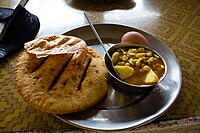
Photo from wikipedia
Introduction Black Tibetan sheep is one of the primitive sheep breeds in China that is famous for its great eating quality and nutrient value but with little attention to the… Click to show full abstract
Introduction Black Tibetan sheep is one of the primitive sheep breeds in China that is famous for its great eating quality and nutrient value but with little attention to the relationship between feeding regimes and rumen metabolome along with its impact on the muscle metabolism and meat quality. Methods This study applies metabolomics-based analyses of muscles and 16S rDNA-based sequencing of rumen fluid to examine how feeding regimes influence the composition of rumen microbiota, muscle metabolism and ultimately the quality of meat from Black Tibetan sheep. Twenty-seven rams were randomly assigned to either indoor feeding conditions (SG, n = 9), pasture grazing with indoor feeding conditions (BG, n = 9) or pasture grazing conditions (CG, n = 9) for 120 days. Results The results showed that, compared with BG and CG, SG improved the quality of Black Tibetan sheep mutton by preventing a decline in pH and increasing fat deposition to enhance the color, tenderness and water holding capacity (WHC) of the Longissimus lumborum (LL). Metabolomics and correlation analyses further indicated that the feeding regimes primarily altered amino acid, lipid and carbohydrate metabolism in muscles, thereby influencing the amino acid (AA) and fatty acid (FA) levels as well as the color, tenderness and WHC of the LL. Furthermore, SG increased the abundance of Christensenellaceae R-7 group, [Eubacterium] coprostanoligenes group, Methanobrevibacter, Ruminococcus 2 and Quinella, decreased the abundance of Lactobacillus, Prevotella 1 and Rikenellaceae RC9 gut group, and showed a tendency to decrease the abundance of Succinivibrio and Selenomonas 1. Interestingly, all of these microorganisms participated in the deposition of AAs and FAs and modified the levels of different metabolites involved in the regulation of meat quality (maltotriose, pyruvate, L-ascorbic acid, chenodeoxycholate, D-glucose 6-phosphate, glutathione, etc.). Discussion Overall, the results suggest that feeding Black Tibetan sheep indoors with composite forage diet was beneficial to improve the mouthfeel of meat, its color and its nutritional value by altering the abundance of rumen bacteria which influenced muscle metabolism.
Journal Title: Frontiers in Microbiology
Year Published: 2023
Link to full text (if available)
Share on Social Media: Sign Up to like & get
recommendations!